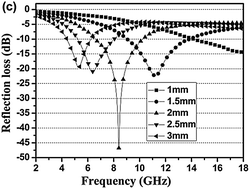Effect of magnetic fillers on the electromagnetic properties of CaCu3Ti4O12–epoxy composites within the 2–18 GHz range
Abstract
The electromagnetic properties of the CaCu3Ti4O12 (CCTO)-magnetic particles–epoxy composite in the frequency range of 2–18 GHz are reported in this paper. The results showed that both the dielectric loss and the magnetic loss of the CCTO–epoxy composite were lower, and the dielectric constant was nearly independent of frequency over the measured frequency range. In order to improve the microwave absorption of the CCTO–epoxy composite, soft magnetic particles (barium ferrite, Fe–Si–Al and carbonyl iron flakes) were introduced. The effect of the magnetic fillers on the electromagnetic properties of the CCTO–epoxy composites within the 2–18 GHz range was also investigated. The experimental results showed that the complex permittivity and permeability of the composites were dependent on the type of filler and the frequency band, and the increasing rates of the real and imaginary parts with respect to the types of fillers were all different. These different rates can have a great effect on the thickness and microwave absorption in the design of single-layer microwave absorbers.


 Please wait while we load your content...
Please wait while we load your content...